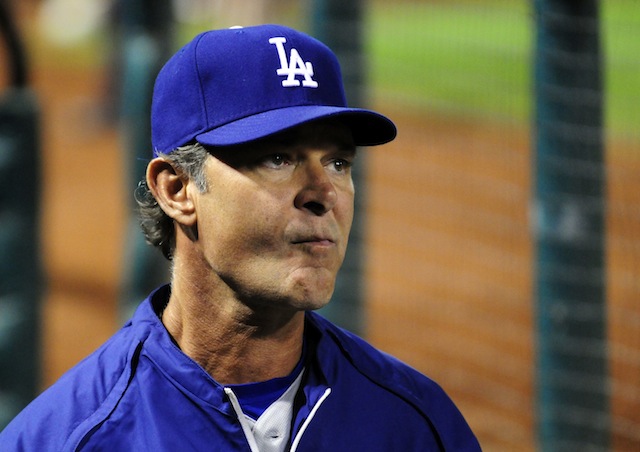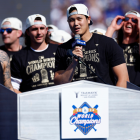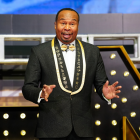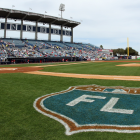
Hall of Fame: Cox, La Russa, Torre get in | Miller snubbed | Steinbrenner's complicated case| One-and-done candidates | Luis Gonzalez's case | Moises Alou's case | Lee Smith's case | Fred McGriff's case
The BBWAA Hall of Fame announcement is less than a month away, and we're in the process of breaking down each of the serious candidates on individual basis.
The idea is simple: we'll provide an argument for each player being a Hall of Famer and then put forth an argument as to why the player in question is not a Hall of Famer. Some will be easier than others, but most are not that obvious. When we're done, you can decide for yourself if the player is Cooperstown worthy.
Today we're going to cover first baseman Don Mattingly.
THE BARE ESSENTIALS
Mattingly spent parts of 14 seasons in the majors, all of them with the Yankees. Over that span, Mattingly tallied 2,153 hits; 222 home runs; 442 doubles; 1,099 RBI; and 1,007 runs scored. On a rate basis, Mattingly authored a career batting line of .307/.358/.471 (127 OPS+) in 7,722 plate appearances.
This will be Mattingly's 14th year on the BBWAA ballot. His support peaked in his first year, 2001, when he was named on 28.2 percent of ballots. Last year, it was down to 13.2 percent. As a reminder, a candidate must be named on at least 75 percent of BBWAA ballots in order to earn election.
THE CASE FOR INDUCTION
Mattingly enjoyed an elite-level peak from 1984-87. Over that span, he batted .337/.381/.560 and averaged 30 homers and 46 doubles per 162 games played. At the back end of that peak, Mattingly was just 26 years of age. Extend it out another two years to include Mattingly's good-but-not-quite-great 1988 and 1989 seasons, and you get a six-year run of .327/.372/.530 (147 OPS+). Obviously, when Mattingly was at his best, he was genuinely great.
He's also a player who conferred a great deal of defensive value. Long regarded as the best defensive first baseman of his generation, Mattingly committed just 64 errors in 14,132 defensive innings at first -- or roughly one every 223 innings in the field. Mattingly's range was also impressive. In fact, in 1986 he became the first left-hander to man third base since Wee Willie Keeler in 1905. In all, Mattingly made at least one appearance at six different positions in his career -- that kind of defensive flexibility is exceedingly rare in a primary first baseman.
As far as hardware and honors go, Mattingly has to his credit six All-Star appearances, nine Gold Gloves, three Silver Sluggers, one AL MVP (1985) and four top-10 finishes in the MVP balloting. Mattingly won a batting title and led the majors in hits once, doubles three times, total bases twice and RBI once. Appealing for some voters is that Mattingly spent his entire career in one uniform, was named team captain prior to the 1991 season and had a tremendous reputation as a clubhouse and on-field leader.
THE CASE AGAINST INDUCTION
Mattingly’s decline phase was sudden and deep, at least by the standards of Hall of Famers. For that, we have his back to blame. Part-way through the 1987 season, Mattingly wrenched his spine, and thus began an ongoing battle with back problems that would alter the course of his career. Mattingly's power developed early in his career thanks in part to some mechanical adjustments suggested to him by then-hitting coach Lou Piniella. However, Mattingly's compromised back didn't permit him to swing as forcefully and fluidly as he had during his best seasons.
As a consequence, here's what happened to Mattingly's power during what should have been his prime:
Source: FanGraphs -- Don Mattingly
As you can see, Mattingly, as measured by slugging percentage, began hovering around the league mean at around age 27. Considering first base is a power position, that cut significantly into Mattingly's value over the remainder of his career. His sapped ability to square up on the ball in tandem with the fact that he never drew a great many walks (lifetime single-season high in unintentional walks was 53, which he registered near the end of his career) rendered Mattingly a merely solid hitter from about 1990 onward. Over the final six seasons of his career, Mattingly averaged just 128 games per season. Better health or better effectiveness almost certainly would've yielded 3,000 hits for Donnie Baseball, but it was not to be.
Mattingly's back condition was eventually revealed to be a congenital disk deformity -- one he worked tirelessly to overcome but, in the end, one that simply couldn't be overcome. Because of that, Mattingly's decline phase didn't afford him the numbers he needed to be a front-line candidate for the Hall.
In typical Mattingly stoic fashion, he never groused about his maladies during his playing days. Only in retirement did he address the back problems that undermined the second half of his career (source: SABR):
"I was born with a congenital defect. If I hit too much, I got a pounding soreness. It was like a dead ache in my back. I still get it today when I go out and hit too many golf balls. ... I tried to make the best of it. I didn't want to talk about it. I didn't want any sympathy from people. I didn't want to hear people say, 'How's your back?' Or, 'He's struggling because of his back.' So what? I was able to play for 12 or 13 years, some of those years feeling pretty good, some of those years not feeling so good. I was still able to play in the major leagues, and I was very thankful for that. I didn't feel it was an area that I really wanted any sympathy for."
Absent such a "pounding soreness," Mattingly would probably already be in Cooperstown, but health is generally regarded as a skill by voters. Mattingly simply lacked it.
Sunday: The case for and against Jack Morris

















